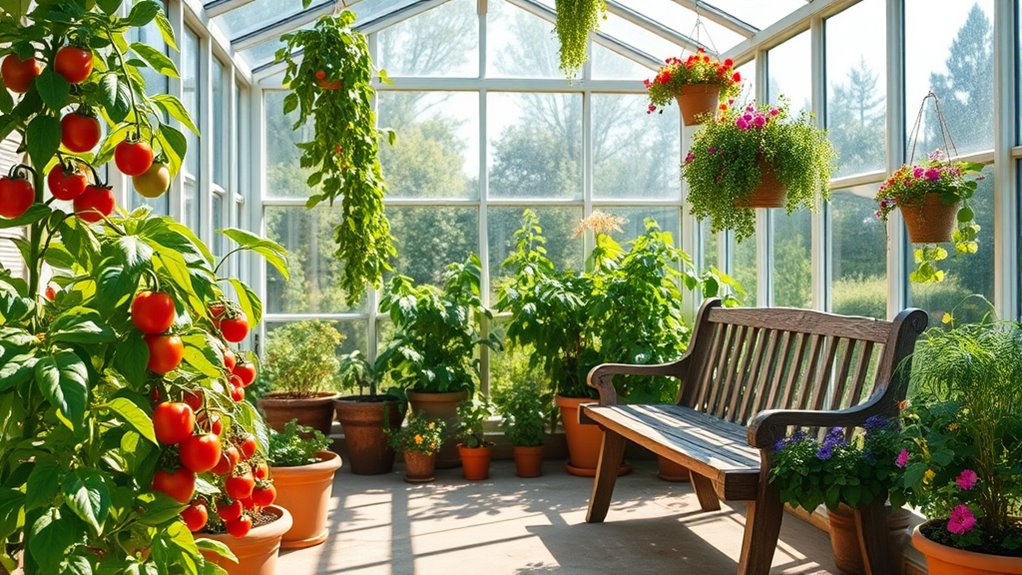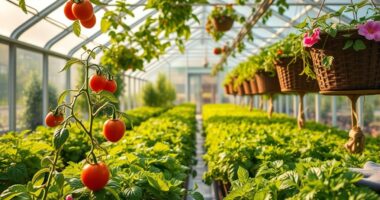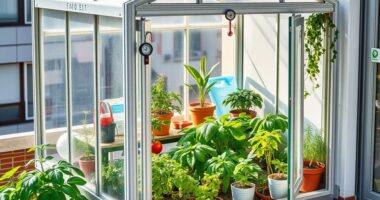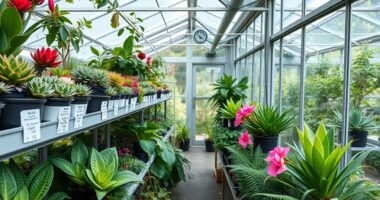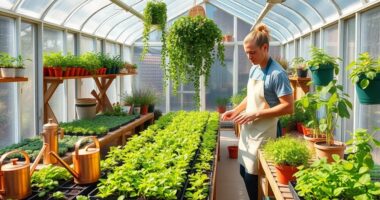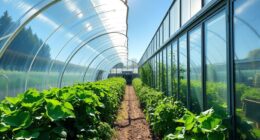Having a backyard greenhouse lets you extend your growing season by up to 60%, giving you the chance to grow a wider variety of crops all year long. You’ll enjoy optimal climate control, leading to healthier plants and higher yields. Plus, effective pest management keeps your crops thriving. With space optimization techniques, you can maximize your gardening area. Overall, a greenhouse can boost your gardening experience and offer other advantages that might surprise you.
Key Takeaways
- A backyard greenhouse extends the growing season by up to 60%, allowing for late fall and early winter crops.
- Controlled environments improve crop quality by minimizing pests and diseases, ensuring healthier plants.
- Year-round production leads to higher crop yields and premium market prices, enhancing economic stability.
- Climate control technologies optimize growth conditions, reducing labor costs with automated systems.
- Space optimization techniques maximize productivity, allowing for diverse crops in limited areas.
Extended Growing Season

When you invest in a greenhouse, you’re not just creating a space to grow plants; you’re significantly extending your growing season.
With a greenhouse, you can enjoy up to 60% longer harvest periods, allowing you to cultivate late fall and early winter crops. You’ll have the flexibility to plant earlier, giving your plants a jump start before they move outdoors.
This extended season means you can explore a wider variety of crops, including those that wouldn’t usually thrive in your local climate. Plus, the controlled environment helps improve crop quality, as your plants face fewer pests and diseases.
Climate Control for Optimal Growth
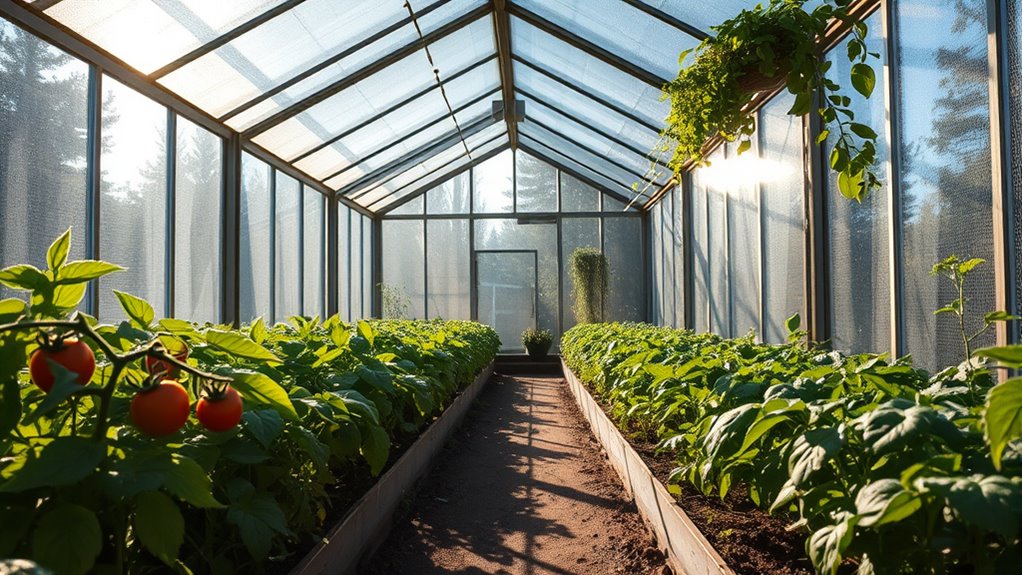
Effective climate control in your greenhouse is crucial for achieving optimal plant growth. By regulating temperature and maintaining humidity, you create an ideal environment for your plants.
Greenhouses trap heat from sunlight, helping to keep temperatures steady, while vents and fans manage excess heat and humidity. This balance supports healthier plants and higher yields.
Greenhouses maintain steady temperatures by trapping sunlight, while vents and fans control excess heat and humidity for optimal plant health.
You can also optimize light, ensuring your plants get enough for photosynthesis. With the right climate control systems, you’ll enjoy year-round production, regardless of outside weather.
Plus, automated controls reduce labor costs and enhance sustainability by using energy efficiently. Overall, effective climate management allows you to grow a diverse range of crops, even those that typically struggle in your local climate.
Effective Pest and Disease Management
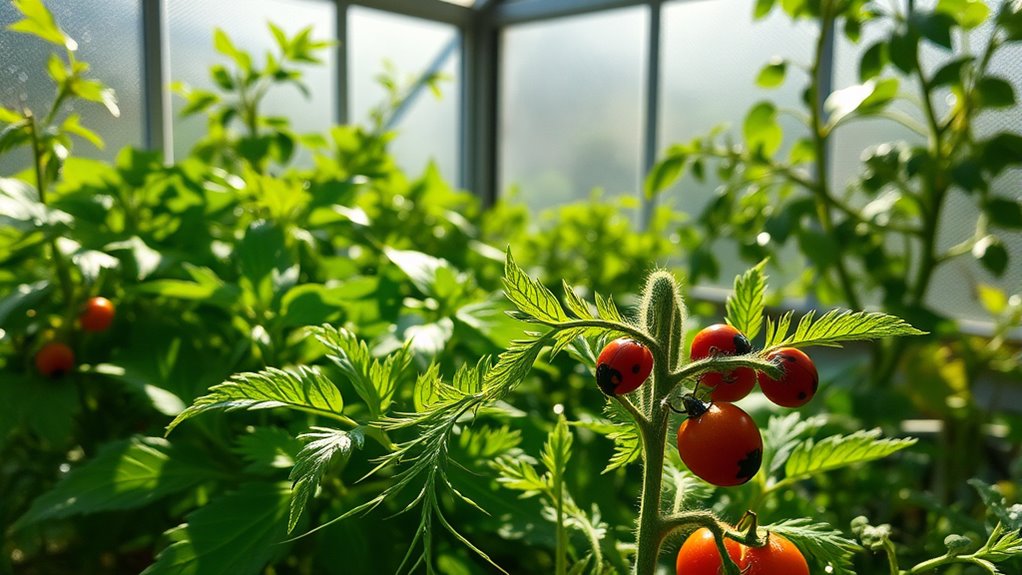
To ensure your greenhouse thrives, managing pests and diseases effectively is essential.
Start by installing insect screens to keep out pests like aphids and whiteflies, while ensuring proper airflow. Create a vegetation-free zone around your greenhouse to further reduce pest habitats.
Incorporate beneficial insects, such as ladybugs and lacewings, to naturally control pest populations. Regular sanitation practices, like removing debris and weeds, help eliminate potential breeding grounds.
If needed, judiciously use insecticidal soaps and neem oil, applying them at the right time. Consistent monitoring with sticky traps allows you to identify issues early.
Space Optimization Techniques
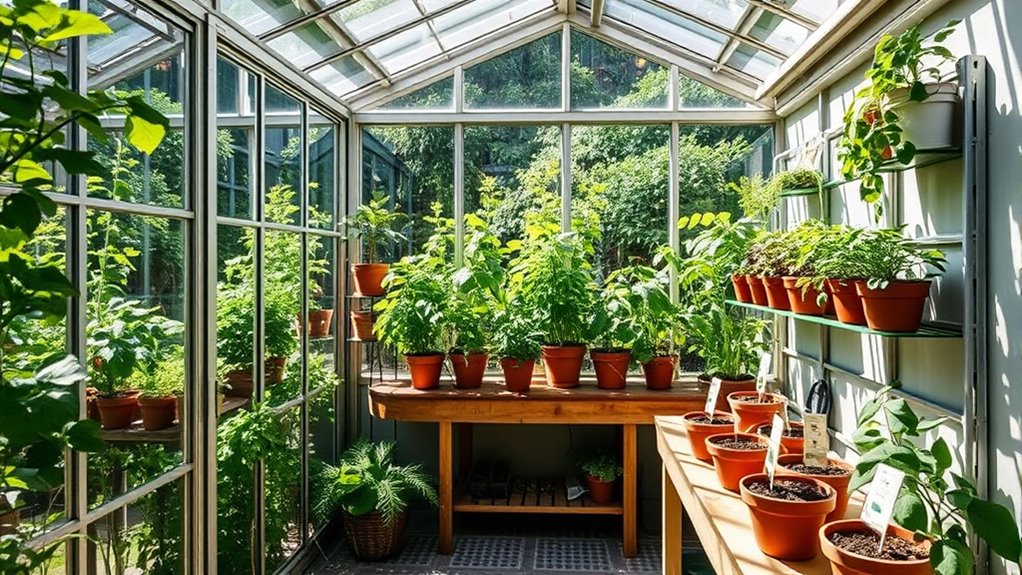
Maximizing space in your greenhouse can transform it into a thriving oasis of growth and productivity.
Start by installing multi-level shelving and tiered plant stands to utilize vertical space effectively. Consider incorporating hanging planters for trailing plants, adding both beauty and functionality.
Hydroponic towers and aeroponic systems allow you to grow more in compact areas while ensuring efficient water use. Utilize your walls with planter walls and hanging baskets to free up floor space.
Design efficient pathways with narrow aisles and compact flooring, ensuring easy access. Don’t forget about ceiling space—use hooks and racks to hang planters and store supplies.
Economic Benefits of Greenhouse Gardening
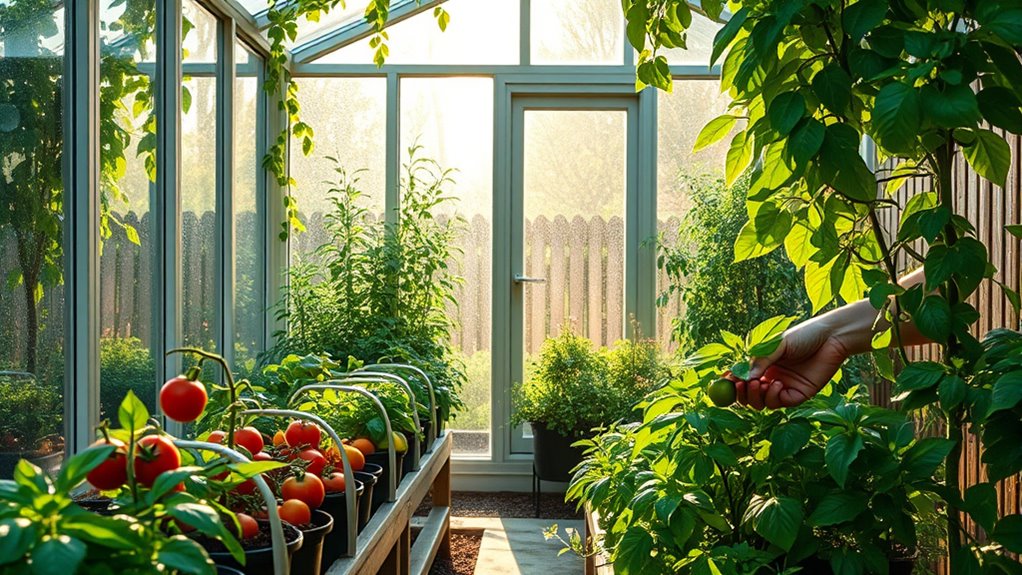
Optimizing space in your greenhouse not only enhances productivity but also opens the door to significant economic advantages.
With year-round production, you can enjoy increased crop yields compared to traditional farming. Your consistent, high-quality crops can command premium market prices, boosting profitability.
Plus, you’ll have stable income streams, reducing the financial impact of weather fluctuations. Government grants and subsidies can help with initial costs, while long-term savings emerge from reduced crop loss and efficient resource use. This is particularly important because greenhouses can extend growing seasons, allowing you to capitalize on off-peak market prices.
By tapping into niche markets and specialty crops, you can diversify your revenue streams. Moreover, the use of energy-efficient models in your greenhouse can lower operational costs, enhancing your overall profitability.
All these factors combined give you a competitive advantage, ensuring your greenhouse venture remains economically viable and sustainable for years to come.
Health and Lifestyle Advantages
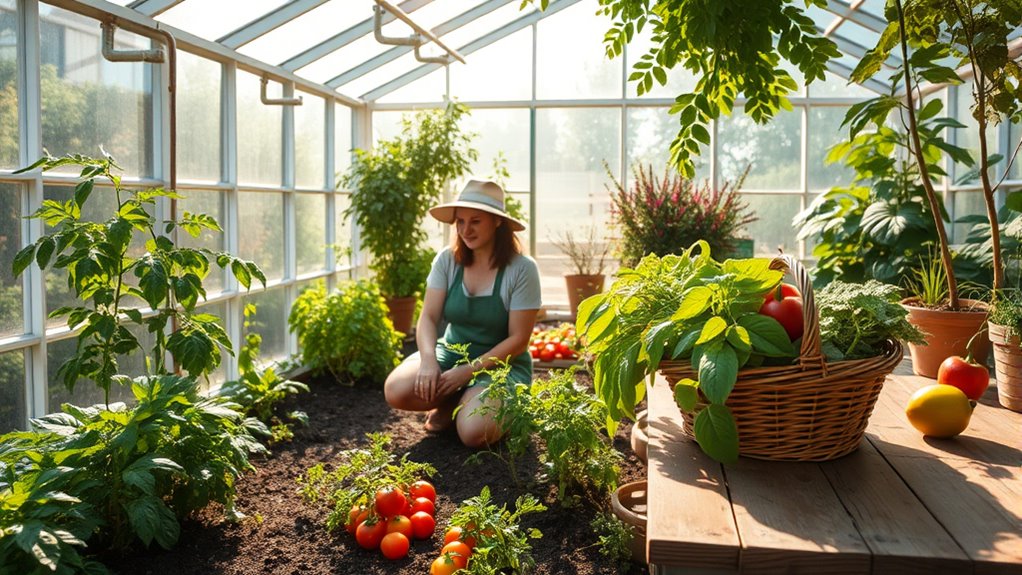
While gardening in a greenhouse offers numerous benefits, its health and lifestyle advantages stand out significantly. Engaging in this calming activity reduces stress and enhances your mental well-being, providing a peaceful retreat from daily life.
The physical tasks involved—like watering and harvesting—improve your strength and cardiovascular health. Plus, you gain access to fresh, nutrient-dense produce, ensuring a healthier diet.
Greenhouse gardening allows you to enjoy this hobby year-round, regardless of weather, fostering relaxation and connection with nature. It also cultivates a sense of accomplishment as you watch your plants thrive.
Whether you’re gardening alone or with family, the community spirit can inspire healthier lifestyles and shared experiences, enriching your overall quality of life. Additionally, backyard greenhouses are an excellent way to extend your growing season, allowing you to enjoy gardening even in colder months.
Environmental Sustainability Through Gardening
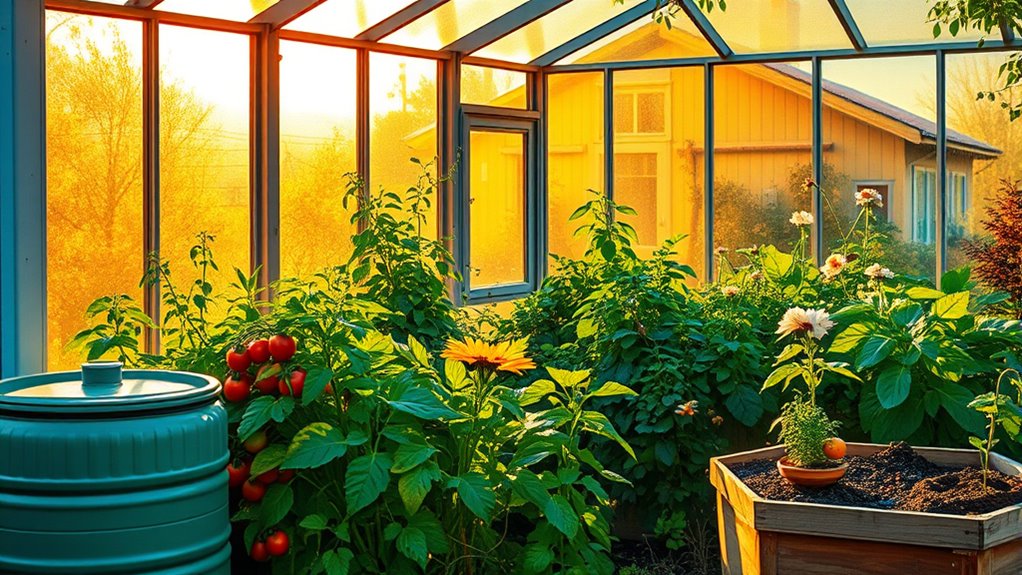
Gardening in a greenhouse not only enhances your well-being but also promotes environmental sustainability. By reducing water evaporation and utilizing efficient irrigation systems, greenhouses help conserve water. They often incorporate solar power and superior insulation, leading to energy efficiency.
Plus, the controlled environment means you can cut down on chemical pesticides and fertilizers, protecting local ecosystems.
You can practice sustainable gardening through composting and rainwater collection, creating a healthy ecosystem. Greenhouses also allow for year-round production, enabling you to grow out-of-season plants and enjoy consistent harvests.
With their durability and adaptability to climate change, greenhouses provide a resilient solution for gardening while supporting biodiversity and reducing your environmental impact.
Frequently Asked Questions
What Types of Plants Thrive Best in a Greenhouse?
When you’re considering plants for your greenhouse, think about varieties that thrive in controlled environments.
Bananas, guavas, and Meyer lemons flourish in warmer conditions. For vegetables, cucumbers, tomatoes, and string beans are excellent choices due to their extended growing seasons.
You can also cultivate vibrant flowers like orchids and bromeliads.
How Much Maintenance Is Required for a Backyard Greenhouse?
Maintaining a backyard greenhouse is like tending to a delicate garden of responsibilities.
You’ll need to clean surfaces regularly to keep disease at bay and ensure sunlight pours in. Inspect the structure for cracks and fix any loose screws.
Don’t forget your equipment; ventilation and irrigation systems require attention, too.
Seasonal deep cleaning and preventive care keep everything thriving.
With dedication, your greenhouse will become a flourishing haven of plant life.
What Are the Initial Costs for Setting up a Greenhouse?
When you’re setting up a greenhouse, initial costs can vary widely. A basic greenhouse kit might start around $3,350, but you’ll need to factor in tax, shipping, and installation, which can add hundreds or even thousands more.
Depending on the size and materials, prices range from $2,000 to $25,000. If you have DIY skills, you might save about 40% compared to hiring professionals for installation.
Always consider extra supplies and permits too.
Can I Use a Greenhouse in a Cold Climate?
Did you know that greenhouses can increase your growing season by up to 3 months in cold climates?
Yes, you can definitely use a greenhouse in a cold climate! They protect your plants from harsh weather and maintain a stable environment for growth.
How Do I Choose the Right Greenhouse Size for My Yard?
To choose the right greenhouse size for your yard, start by assessing available space and layout. Measure the maximum footprint you can accommodate, ensuring you leave room for access paths.
Think about your gardening goals—what plants you want to grow and how many. If you’re new to gardening, consider starting small.
Finally, factor in your budget, as larger greenhouses require a higher initial investment and ongoing maintenance costs.
Conclusion
Imagine stepping into your backyard greenhouse, where the air is warm and fragrant with the scent of fresh soil and budding plants. You’ve not only extended your growing season but also created a sanctuary for your vegetables and flowers. With effective pest management and a space that thrives with life, you’re reaping economic benefits while nurturing your health. Embracing this green haven, you’re not just gardening; you’re cultivating a sustainable lifestyle that blooms with beauty and purpose.
